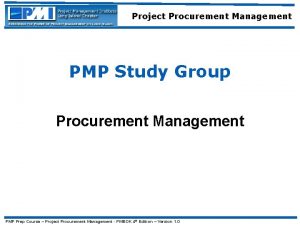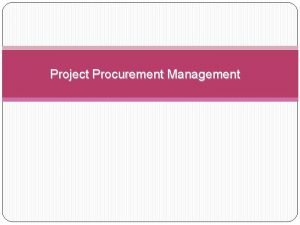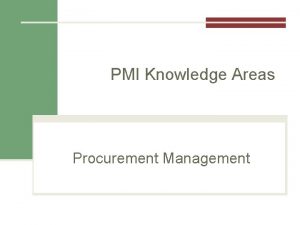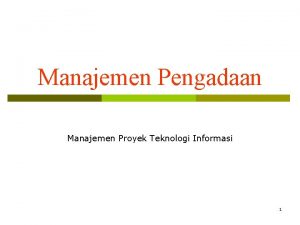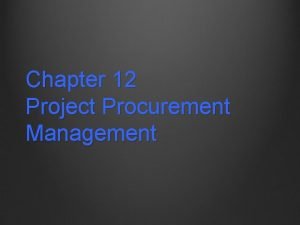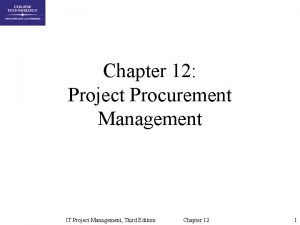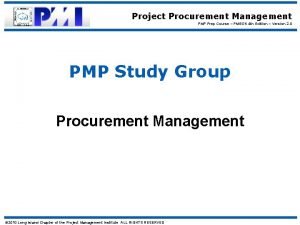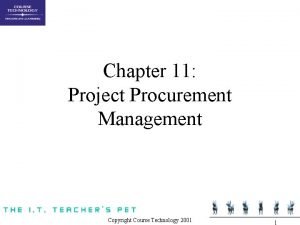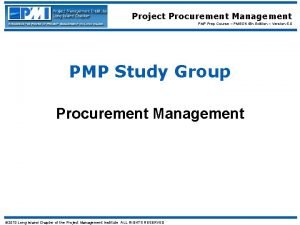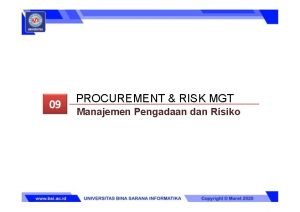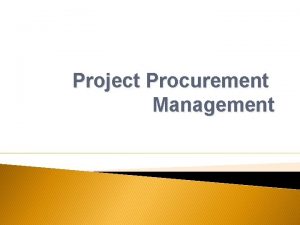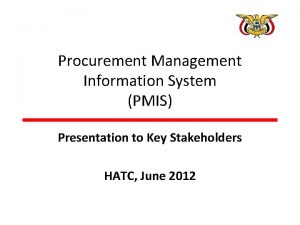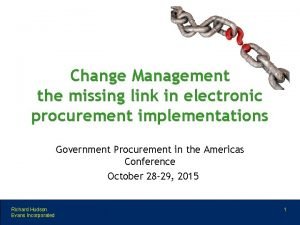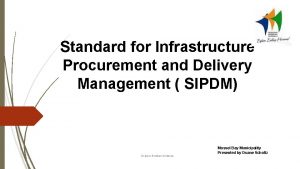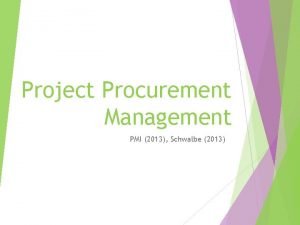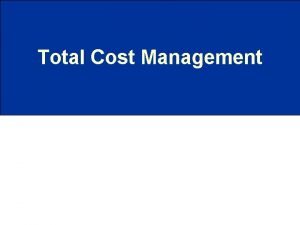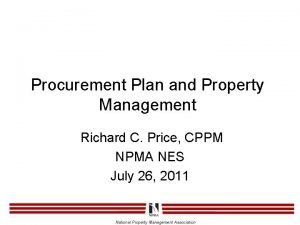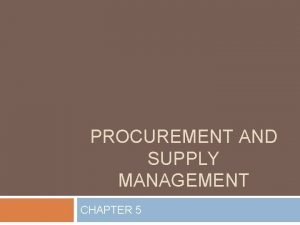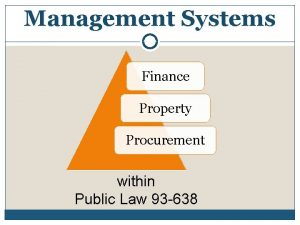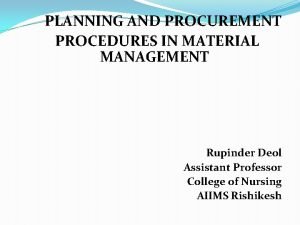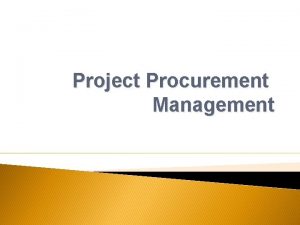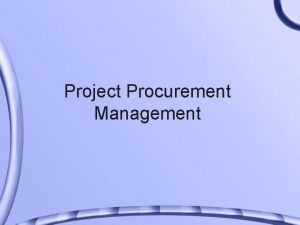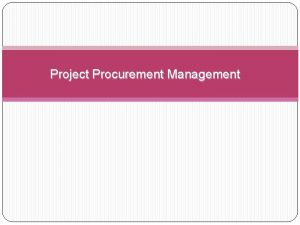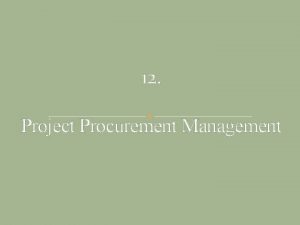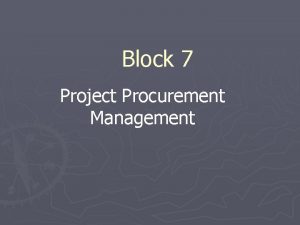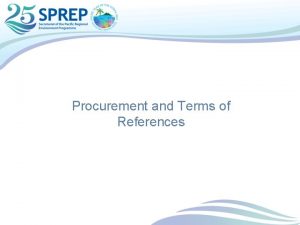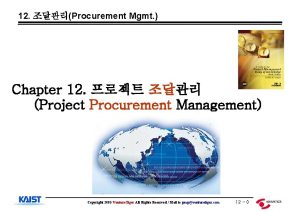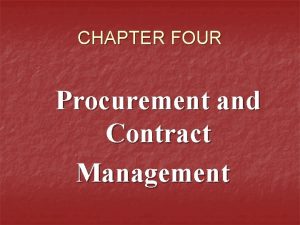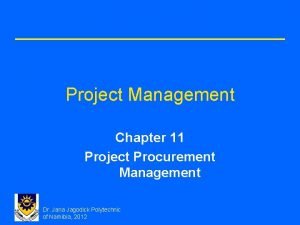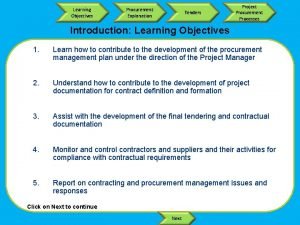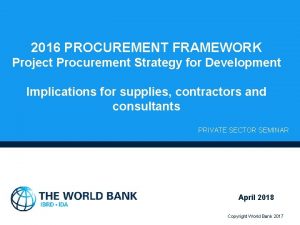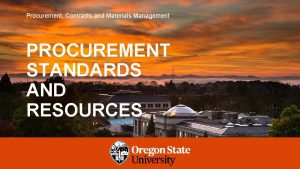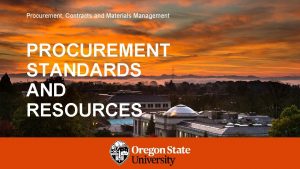Chapter 12 Project Procurement Management IT Project Management




























- Slides: 28

Chapter 12: Project Procurement Management IT Project Management, Third Edition Chapter 12 1

Learning Objectives • Understand the importance of project procurement management and the increasing use of outsourcing for information technology projects • Describe the procurement planning process, procurement planning tools and techniques, types of contracts, and statements of work • Discuss what is involved in solicitation planning and the difference between a request for proposal and a request for quote • Explain what occurs during the solicitation process IT Project Management, Third Edition Chapter 12 2

Learning Objectives • Describe the source selection process and different approaches for evaluating proposals or selecting suppliers • Discuss the importance of good contract administration • Describe the contract close-out process • Discuss types of software available to assist in project procurement management IT Project Management, Third Edition Chapter 12 3

Importance of Project Procurement Management • Procurement means acquiring goods and/or services from an outside source • Other terms include purchasing and outsourcing • Experts predicted that by the year 2003 the worldwide information technology outsourcing market would grow to over $110 billion • U. S. federal spending on IT outsourcing is projected to increase from $6. 6 billion in 2002 to nearly $15 billion by 2007 due to an emphasis on e-government, homeland security, and the shortage of IT workers in government IT Project Management, Third Edition Chapter 12 4

Why Outsource? • To reduce both fixed and recurrent costs • To allow the client organization to focus on its core business • To access skills and technologies • To provide flexibility • To increase accountability IT Project Management, Third Edition Chapter 12 5

Project Procurement Management Processes • Procurement planning: determining what to procure and when • Solicitation planning: documenting product requirements and identifying potential sources • Solicitation: obtaining quotations, bids, offers, or proposals as appropriate • Source selection: choosing from among potential vendors • Contract administration: managing the relationship with the vendor • Contract close-out: completion and settlement of the contract IT Project Management, Third Edition Chapter 12 6

Figure 12 -1. Project Procurement Management Processes and Key Outputs IT Project Management, Third Edition Chapter 12 7

Procurement Planning • Procurement planning involves identifying which project needs can be best met by using products or services outside the organization. It includes deciding – – – whether to procure how to procure what to procure how much to procure when to procure IT Project Management, Third Edition Chapter 12 8

What Went Right? • Several organizations, such as The Boots Company PLC in England, outsourced their IT services to save money compared with running the systems themselves • Carefully planning procurement can also save millions of dollars, as the U. S. Air Force did by using a flexible pricing strategy for a large office automation project IT Project Management, Third Edition Chapter 12 9

Procurement Planning Tools and Techniques • Make-or-buy analysis: determining whether a particular product or service should be made or performed inside the organization or purchased from someone else. Often involves financial analysis • Experts, both internal and external, can provide valuable inputs in procurement decisions IT Project Management, Third Edition Chapter 12 10

Make-or Buy Example • Assume you can lease an item you need for a project for $150/day. To purchase the item, the investment cost is $1, 000, and the daily cost would be another $50/day. • How long will it take for the lease cost to be the same as the purchase cost? • If you need the item for 12 days, should you lease it or purchase it? IT Project Management, Third Edition Chapter 12 11

Make-or Buy Solution • Set up an equation so the “make” is equal to the “buy” • In this example, use the following equation. Let d be the number of days to use the item. $150 d = $1, 000 + $50 d • Solve for d as follows: – Subtract $50 d from the right side of the equation to get $100 d = $1, 000 – Divide both sides of the equation by $100 d = 10 days • The lease cost is the same as the purchase cost at 10 days • If you need the item for 12 days, it would be more economical to purchase it IT Project Management, Third Edition Chapter 12 12

Types of Contracts • Fixed-price or lump-sum: involve a fixed total price for a well-defined product or service • Cost-reimbursable: involve payment to the seller for direct and indirect costs • Time and material contracts: hybrid of both fixed-price and cost-reimbursable, often used by consultants • Unit price contracts: require the buyer to pay the seller a predetermined amount per unit of service IT Project Management, Third Edition Chapter 12 13

Cost Reimbursable Contracts • Cost plus incentive fee (CPIF): the buyer pays the seller for allowable performance costs plus a predetermined fee and an incentive bonus • Cost plus fixed fee (CPFF): the buyer pays the seller for allowable performance costs plus a fixed fee payment usually based on a percentage of estimated costs • Cost plus percentage of costs (CPPC): the buyer pays the seller for allowable performance costs plus a predetermined percentage based on total costs IT Project Management, Third Edition Chapter 12 14

Figure 12 -2. Contract Types Versus Risk IT Project Management, Third Edition Chapter 12 15

Statement of Work (SOW) • A statement of work is a description of the work required for the procurement • Many contracts, or mutually binding agreements, include SOWs • A good SOW gives bidders a better understanding of the buyer’s expectations IT Project Management, Third Edition Chapter 12 16

Figure 12 -3. Statement of Work (SOW) Template IT Project Management, Third Edition Chapter 12 17

Solicitation Planning • Solicitation planning involves preparing several documents: – Request for Proposals: used to solicit proposals from prospective sellers – Requests for Quotes: used to solicit quotes for well-defined procurements – Invitations for bid or negotiation and initial contractor responses are also part of solicitation planning IT Project Management, Third Edition Chapter 12 18

Figure 12 -4. Outline for a Request for Proposal (RFP) IT Project Management, Third Edition Chapter 12 19

Solicitation • Solicitation involves obtaining proposals or bids from prospective sellers • Organizations can advertise to procure goods and services in several ways – approaching the preferred vendor – approaching several potential vendors – advertising to anyone interested • A bidders’ conference can help clarify the buyer’s expectations IT Project Management, Third Edition Chapter 12 20

Source Selection • Source selection involves – – evaluating bidders’ proposals choosing the best one negotiating the contract awarding the contract • It is helpful to prepare formal evaluation procedures for selecting vendors • Buyers often create a “short list” IT Project Management, Third Edition Chapter 12 21

Figure 12 -5. Sample Proposal Evaluation Sheet IT Project Management, Third Edition Chapter 12 22

Figure 12 -6. Detailed Criteria for Selecting Suppliers IT Project Management, Third Edition Chapter 12 23

Be Careful in Selecting Suppliers and Writing Their Contracts • Many dot-com companies were created to meet potential market needs, but many went out of business, mainly due to poor business planning, lack of senior management operations experience, lack of leadership, and lack of visions. Check the stability of suppliers • Even well-known suppliers can impede project success. Be sure to write and manage contracts well with all suppliers (see What Went Wrong? ) IT Project Management, Third Edition Chapter 12 24

Contract Administration • Contract administration ensures that the seller’s performance meets contractual requirements • Contracts are legal relationships, so it is important that legal and contracting professionals be involved in writing and administering contracts • Many project managers ignore contractual issues, which can result in serious problems IT Project Management, Third Edition Chapter 12 25

Suggestions on Change Control for Contracts • Changes to any part of the project need to be reviewed, approved, and documented by the same people in the same way that the original part of the plan was approved • Evaluation of any change should include an impact analysis. How will the change affect the scope, time, cost, and quality of the goods or services being provided? • Changes must be documented in writing. Project team members should also document all important meetings and telephone calls IT Project Management, Third Edition Chapter 12 26

Contract Close-out • Contract close-out includes – product verification to determine if all work was completed correctly and satisfactorily – administrative activities to update records to reflect final results – archiving information for future use • Procurement audits identify lessons learned in the procurement process IT Project Management, Third Edition Chapter 12 27

Using Software to Assist in Project Procurement Management • • Word processing software helps in writing proposals and contracts, spreadsheets help in evaluating suppliers, databases help track suppliers, and presentation software aids in presenting procurement-related information In the late 1990 s and early 2000 s, many companies started using e-procurement software to do many procurement functions electronically Companies such as Commerce One, Ariba, Concur Technologies, SAS, and Baan provide corporate procurement services over the Internet Organizations also use other Internet tools to help find information on suppliers or auction goods and services IT Project Management, Third Edition Chapter 12 28
 Project procurement management lecture notes
Project procurement management lecture notes Procurement project management
Procurement project management Project procurement management process
Project procurement management process Project procurement management process
Project procurement management process Contoh pengadaan dalam sebuah proyek ti
Contoh pengadaan dalam sebuah proyek ti Conduct procurement tools and techniques
Conduct procurement tools and techniques Importance of project procurement management
Importance of project procurement management Solicitation planning example
Solicitation planning example Project procurement management pmbok
Project procurement management pmbok Project procurement management mainly involves:
Project procurement management mainly involves: Project procurement management pmbok
Project procurement management pmbok Sebutkan 4 proses dari project procurement management
Sebutkan 4 proses dari project procurement management Importance of project procurement management
Importance of project procurement management Introduction for project
Introduction for project Procurement management information system
Procurement management information system Change management in eprocurement
Change management in eprocurement Infrastructure procurement and delivery management
Infrastructure procurement and delivery management Pmi procurement
Pmi procurement Strategic cost management procurement
Strategic cost management procurement Property management systems procurement
Property management systems procurement Procurement material management
Procurement material management Property management systems procurement
Property management systems procurement Material management planning and procurement
Material management planning and procurement The role of project management in achieving project success
The role of project management in achieving project success Modern project profiles in software project management
Modern project profiles in software project management Cost duration graph
Cost duration graph Modern project management began with what project
Modern project management began with what project Project evaluation in software project management
Project evaluation in software project management Perpetual project closure
Perpetual project closure

